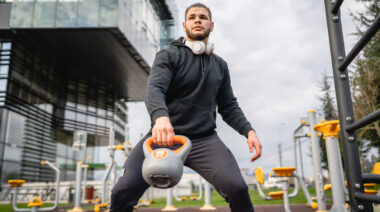Anyone familiar with my previous work will understand my love for the kettlebell. This love is rooted in the utility and versatility of the implement. Kettlebells provide many completely unique training stimuli because they are primarily meant to be used in a single hand. This inherently creates unilateral and single-side-dominant movements that tend to closely mimic natural movement patterns, and close any lateral strength and mobility imbalances.
Even cursory kettlebell experience will arm athletes with many different single-arm exercises. Movements like single-arm swings, presses, cleans, and snatches all earn their unilateral distinction by placing the bell in a single hand. While these movements create an uneven load in the lower body as well, the asymmetry is minimal. Full core engagement and proper form, even during movements like a single-arm swing or snatch, will only create slightly heavier loading in the working-side leg.
This is not a bug, but a feature. One of the core’s primary roles in exercise, as in life, is to provide a solid supporting bridge to distribute unbalanced loads through the lower body. Thus, single-arm kettlebell movements challenge the core, rather than focusing the work through a single leg.
But what if your training objective is to target single leg strength? With all the versatility that kettlebells provide, is there a way to load a single leg using the hip hinge pattern of the classic kettlebell swing?
Enter the Kickstand Swing and the Walking Swing
These two movements channel the power generation from the classic, two-hand kettlebell swing through a single leg. Both create a loading scenario that all but eliminates one leg’s ability to do work, placing the complete burden on the other.
Kickstand Swings
Kickstand swings look quite similar to the classic kettlebell swing, with a single key difference. Lift one heel off the ground to remove that leg’s contribution to the movement. The higher you lift that heel, the greater burden you will place on the other leg. A slightly raised heel largely takes the posterior chain out of the equation but will still allow you to drive through the balls of your feet. To place nearly the entire load through the opposite leg, lift your heel as high as possible. You’re on the right track if you feel like a ballerina on point or like your foot is about to leave the ground.
From this position, perform swings just as you normally would. Focus on maintaining a tight core and fully engaging your planted leg. Be prepared to feel the burn in your working-side butt!
Walking Swings
Like the kickstand swing, walking swings seek to eliminate any contribution from one leg. The walking swing accomplishes this unilateral loading by requiring you to lift a foot as you reach full extension.
The bottom half of a walking swing, both on the way up and down, looks identical to a classic swing, with both feet firmly planted. The difference comes as you begin to extend into the standing position. For walking swings to the left, transfer all your weight onto your left foot while driving into extension. As you reach the standing phase, step your right foot in toward your left. This will leave you standing with feet close (roughly under your hips) as the kettlebell reaches its apex. As the bell begins to descend, step your left foot out to re-establish your swing stance. Repeating this sequence will see you side-stepping your way across the gym while focusing nearly all of the power-generation through your leading leg.
Have Fun and Pay Attention
Both kickstand and walking swings offer fun and variety to your standard swing regimen. Playing with the sequencing can bring some freshness and awareness to an otherwise mundane set of swings. This also adds a mental challenge, mandating the awareness discussed above. Two of my favorite games are:
- 2 Steps Forward, One Step Back – Make your way across the floor with two steps in one direction and one step back. Rest as needed because this can make for long sets. You can also make a 180 degree turn, swapping the lead leg but continuing to move toward the same wall.
- The Kickstand Swing Dance – During the float phase of a kickstand swing, swap the planted and kickstand foot to dance back and forth over the set.
As with all single-side movements, pay attention to any differences that arise. Unilateral movements offer the perfect tool to spotlight any imbalances you have. I never advise simply “going through the motions” while training, but pay especially close attention during unilateral movements. They can be wonderful teachers when you observe and listen.
Go beyond the regular swing:






